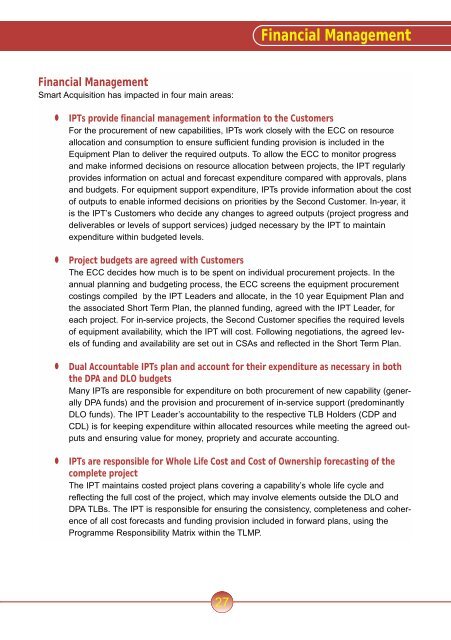The Acquisition Handbook
The Acquisition Handbook
The Acquisition Handbook
- No tags were found...
Create successful ePaper yourself
Turn your PDF publications into a flip-book with our unique Google optimized e-Paper software.
Financial ManagementFinancial ManagementSmart <strong>Acquisition</strong> has impacted in four main areas:• IPTs provide financial management information to the CustomersFor the procurement of new capabilities, IPTs work closely with the ECC on resourceallocation and consumption to ensure sufficient funding provision is included in theEquipment Plan to deliver the required outputs. To allow the ECC to monitor progressand make informed decisions on resource allocation between projects, the IPT regularlyprovides information on actual and forecast expenditure compared with approvals, plansand budgets. For equipment support expenditure, IPTs provide information about the costof outputs to enable informed decisions on priorities by the Second Customer. In-year, itis the IPT’s Customers who decide any changes to agreed outputs (project progress anddeliverables or levels of support services) judged necessary by the IPT to maintainexpenditure within budgeted levels.•Project budgets are agreed with Customers<strong>The</strong> ECC decides how much is to be spent on individual procurement projects. In theannual planning and budgeting process, the ECC screens the equipment procurementcostings compiled by the IPT Leaders and allocate, in the 10 year Equipment Plan andthe associated Short Term Plan, the planned funding, agreed with the IPT Leader, foreach project. For in-service projects, the Second Customer specifies the required levelsof equipment availability, which the IPT will cost. Following negotiations, the agreed levelsof funding and availability are set out in CSAs and reflected in the Short Term Plan.• Dual Accountable IPTs plan and account for their expenditure as necessary in boththe DPA and DLO budgetsMany IPTs are responsible for expenditure on both procurement of new capability (generallyDPA funds) and the provision and procurement of in-service support (predominantlyDLO funds). <strong>The</strong> IPT Leader’s accountability to the respective TLB Holders (CDP andCDL) is for keeping expenditure within allocated resources while meeting the agreed outputsand ensuring value for money, propriety and accurate accounting.•IPTs are responsible for Whole Life Cost and Cost of Ownership forecasting of thecomplete project<strong>The</strong> IPT maintains costed project plans covering a capability’s whole life cycle andreflecting the full cost of the project, which may involve elements outside the DLO andDPA TLBs. <strong>The</strong> IPT is responsible for ensuring the consistency, completeness and coherenceof all cost forecasts and funding provision included in forward plans, using theProgramme Responsibility Matrix within the TLMP.27
















